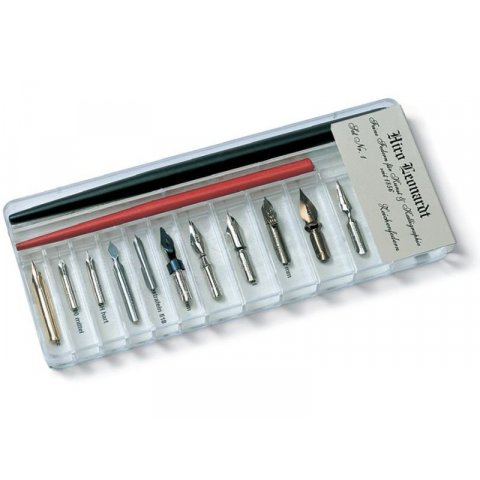| Location in Store | EGD41A |
|---|---|
| Article No. | 0261701 |
various nib assortments, incl. holder and pick-up magnet, in transparent plastic case with labeled compartments
The various nib assortments were assembled so as to provide a good cross section of the available writing and drawing nibs for a variety of applications. A magnet is provided to make it easier to pick up the little nibs. More detailed information about using the individual nibs can be found under Hiro Leonardt writing and drafting nibs .
Set 1 contains various nibs that are primarily intended for drawing purposes while a few can also be used for writing. Contents: Copying nib, flexible; fine crown nib, Bandzug (Tape) nib 0.5 mm; extra fine point nib; ball pointed nib with rounded point; ornamental nib 5 mm; Brandauer extra fine and flexible lithography nib; vaccinostyle and cutting nib for scratchboard and lino cutting; hard drawing nib; medium hard drawing nib; school and drawing nib; 1 standard nib holder and 1 nib holder for fine nibs (hard and medium hard nibs), pick-up magnet.
Set 2 contains school and calligraphy nibs that are suitable for beginners, for general writing purposes but also for making beautiful script. Contents: Stenographer nib, very flexible; school nib 0.5 mm with rounded point; Bandzug (Tape) nibs 1.0/2.0/3.0/4.0 mm; ornamental nibs 0.5/1.5/2.5/3.5 mm; poster nib 5.0 mm; extra fine tubular nib with nib holder; 1 standard nib holder, pick-up magnet.
Set 3 contains Bandzug (Tape) and poster nibs that can be best used for calligraphy and for large-format writing and drawing purposes. Contents: Bandzug nibs 0.5/1.0/1.5/2.0/2.5/3.0/4.0 mm; poster nibs 5.0/6.0/8.0/10.0 mm; 1 standard nib holder; pick-up magnet.
Set 4 contains ornamental nibs for writing and drawing which have a ladle shaped point for making evenly wide lines. Also has a stenographer nib with a very flexible point that is especially good for creating so-called Old English script. Contents: Ornamental nibs 0.5/0.75/1.0/1.5/2.0/2.5/3.0/3.5/4.0/5.0; stenographer nib; 1 standard nib holder; pick-up magnet.
In order to draw and write with nibs and ink you will need paper or paperboard with a smooth surface so that the nib can glide smoothly over it. Paper that has both internal sizing and surface (tub) sizing is recommended because it prevents the ink from bleeding and increases the brightness of the colours being used. A soft paper, or one with a rough surface, can tend to puff up when written on with a nib pen, which can end up making the nib jam into the paper especially when making quick strokes. Drawing inks are very often also used on acetate film. In this case, however, preliminary trials are necessary in order to be cetain that the ink will be absorbed. Among the types of paper that are great for use with ink and nibs are elephant hide, the paper in the Hahnemühle pen and ink drawing pad or the satined paper found in the Clairefontaine writing pads and notebooks.
Free standard delivery within Germany and free collection from Modulor in Berlin for orders over 89 €.
5,95 € shipping costs, if order value is less than 89 € (DE)
2,95 € for pick-up at the store in Berlin, if order value is less than 89 €
Express and forwarding shipping
From 19 € express surcharge you will receive your order particularly quickly with standard shipping within Germany.
From 69€ is the cost of shipping within Germany. You can recognize articles with forwarding shipping in the store by the truck symbol .
Especially for Berlin
From 34.90 € courier shipping for standard and forwarding goods.
- Free returns for standard shipping within Germany
- Extended, voluntary return policy of 30 days for complete, undamaged goods in their original packaging
- You are responsible for the cost of returns for forwarding goods and returns from a country outside Germany
Excluded from returns
Excluded from returns are sections of rolled goods, cut-to-size pieces and other goods made especially for you, as well as used goods, newspapers, magazines and periodicals, Modulor vouchers and items that we do not carry in our range but have ordered at your request.
Good to know: The furniture variants in our configurators that can be delivered quickly are not cut to size, but standard formats that can be returned.
